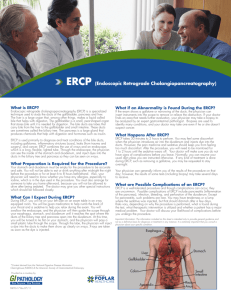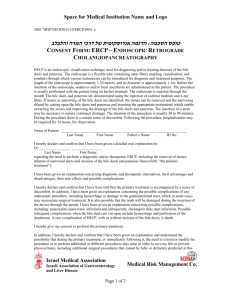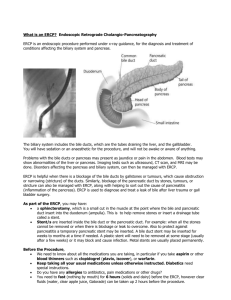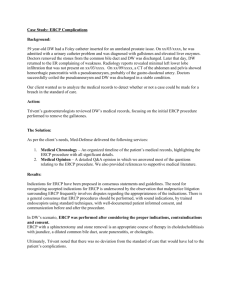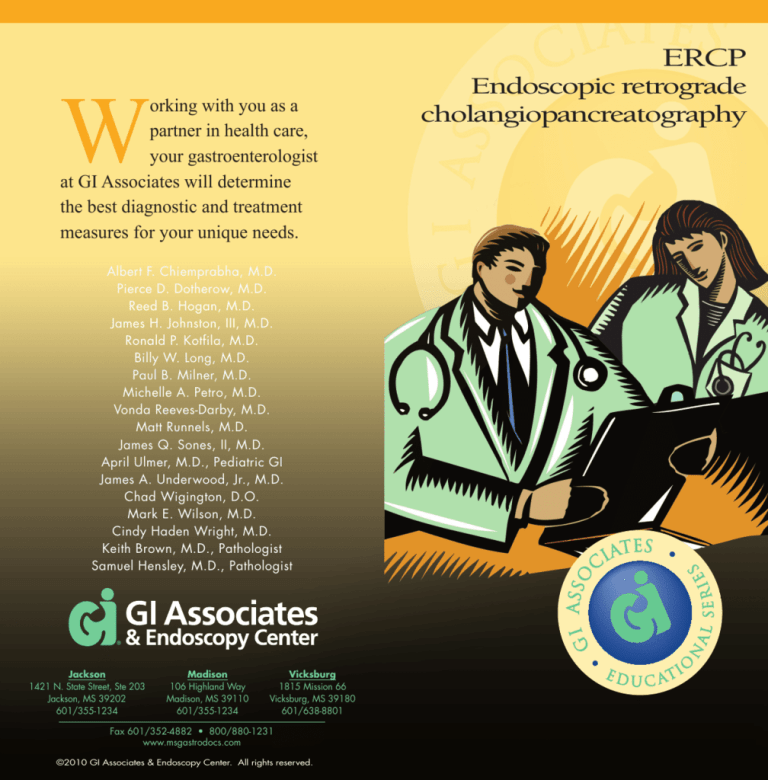
ERCP
W
orking with you as a
partner in health care,
your gastroenterologist
at GI Associates will determine
the best diagnostic and treatment
measures for your unique needs.
Albert F. Chiemprabha, M.D.
Pierce D. Dotherow, M.D.
Reed B. Hogan, M.D.
James H. Johnston, III, M.D.
Ronald P. Kotfila, M.D.
Billy W. Long, M.D.
Paul B. Milner, M.D.
Michelle A. Petro, M.D.
Vonda Reeves-Darby, M.D.
Matt Runnels, M.D.
James Q. Sones, II, M.D.
April Ulmer, M.D., Pediatric GI
James A. Underwood, Jr., M.D.
Chad Wigington, D.O.
Mark E. Wilson, M.D.
Cindy Haden Wright, M.D.
Keith Brown, M.D., Pathologist
Samuel Hensley, M.D., Pathologist
Jackson
1421 N. State Street, Ste 203
Jackson, MS 39202
601/355-1234
Madison
106 Highland Way
Madison, MS 39110
601/355-1234
Vicksburg
1815 Mission 66
Vicksburg, MS 39180
601/638-8801
Fax 601/352-4882 • 800/880-1231
www.msgastrodocs.com
©2010 GI Associates & Endoscopy Center. All rights reserved.
Endoscopic retrograde
cholangiopancreatography
Table of Contents
About endoscopic exams
1. ERCP
3. Why is it needed?
4. Preparation
5. During the Procedure
6. After the Procedure
("
,,
-
.
-
+
",
,
"
8. Summary
"( ' %
,
E-50
Getting the results of
your ERCP
Often you will be told the results as soon as the
sedation wears off. But, the results of some tests that
may have to be done during the procedure will
require a wait of several days. Your physician or
nurse will tell you when the results can be expected.
ERCP
Endoscopic retrograde
cholangiopancreatography
Cystic Duct
Summary
ERCP is an extremely valuable tool for the diagnosis
and treatment of many GI conditions. It is safe and
usually causes minimal discomfort to the patient.
Your GI physician has recommended this procedure
for you because it will contribute to the diagnosis or
treatment of your particular problem.
Serious complications
from this procedure
are very rare.
Liver
Gall Bladder
Common Bile Duct
Duodenum
Pancreas
An ERCP procedure is known as endoscopy of the
drainage ducts of the gallbladder, pancreas and
liver. Although other diagnostic tests are valuable
and still play an important role in some cases,
endoscopy is an awesome tool. It even allows the
physician to perform biopsies and certain procedures to treat problems. The physician can also take
color photographs of the inside of the GI tract.
Endoscopy is simply the best diagnostic
tool available to GI physicians.
What is an endoscope?
Please ask us about any additional questions that
you may have. Working as partners in your care, we
can expect the best possible procedure and treatment
outcome.
Endoscopes let physicians see directly into the
inside of the GI tract. Before endoscopes, physicians
had to use other types of tests and make educated
guesses about the nature of the problem inside the
GI tract, unless surgery was done.
1
An endoscope (as shown in the illustration), consists of a hollow tube that contains thousands of
glass fibers called fiberoptics. The bundle of
fiberoptics allows light to be transmitted to the tip
of the endoscope, to literally “light up” the inside of
the GI tract. A lens system also allows digital
images to be transmitted back to the
other end of the endoscope, so
the physician can see the inside of your GI tract.
During an endoscope
procedure, the GI physician
can view the entire journey of the
endoscope on a computer monitor,
which greatly enhances the physician’s ability to
see changes in the GI tract.
Endoscopy is a safe, effective
diagnostic tool that is more
accurate than X-ray
examination. In addition
to being able to inspect
the inside of the GI tract,
endoscopy helps the physician find sources of bleeding, identify lesions (such
as tumors or ulcers) and
also allows the physician
to actually treat some
problems during the procedure.
A small open channel
within the endoscope tube
allows the physician to use
accessory instruments that can cauterize bleeding
areas, remove small growths or inject solutions. Other
tiny instruments can collect biopsy specimens that can
be sent to a laboratory for further tests.
Since endoscopy is usually an out-patient procedure, a tremendous amount of time and money is
saved by avoiding hospitalization. Surgery is also
avoided in some cases. Another major plus of the
2
This procedure was recommended because it is
the best and safest option for your situation.
However, as with all procedures, there is a
small chance of complications. The following
complications may occur, but are relatively rare:
• Bleeding may occur at the site of any biopsies or
small incisions that were done during the procedure. Usually it is a very small amount, but in rare
cases, it might require a transfusion or surgery.
• A tear or perforation of the area examined might
occur, but this is also very uncommon. The tear
might seal itself, or might require hospitalization
and emergency surgery to repair the tear.
• Pancreatitis (inflammation of the pancreas) or other
infections might occur, but this occurs in less than
5% (1 in 20) of patients. If pancreatitis does
occur, hospitalization may be required for several
days, sometimes longer. Pancreatitis can be life
threatening.
• Other general risks include unexpected drug reactions or severe complications related to sedation
or related to another disease, such as pre-existing
heart or lung disease. Death, disability or loss of
limbs as a complication of ERCP is extremely rare.
7
After the Procedure
Afterwards, you will rest until the effects of the
sedative subside. If your test is done as an outpatient, you will need to have someone there to drive
you home. In some cases, overnight observation
after the procedure is needed.
You may have some discomfort of your throat after
the procedure and the physician or nurse will tell
you what diet to follow after the procedure.
Some patients notice soreness or a tender bump at
the site of the I.V. That irritation is caused by the
medications that are given. It will slowly disappear,
but may take weeks and rarely, months. Notify
your physician if you have increased pain, redness
or fever associated with this.
endoscope is that it literally saves lives, through early
diagnosis and treatment of various GI problems.
ERCP (Endoscopic retrograde
cholangiopancreatography)
ERCP is a special endoscopic examination that
focuses on viewing the ducts (drainage tubes) of
the gallbladder, the pancreas and the liver.
Why is it needed?
ERCP is used to diagnose many diseases of the pancreas, gallbladder or liver. Your physician has ordered
this test because your symptoms, history, laboratory
tests or x-rays suggest that you might have a problem
in this area. ERCP can help your physician find out
if any of the drainage tubes are blocked and can
help determine whether or not surgery or additional treatment is needed for your problem.
Blockage of any of the small ducts can cause major
problems. The common bile duct carries bile from the
gallbladder and other enzymes from the pancreas to
the duodenum, the first section of the small intestine.
When these ducts are blocked, pain and infection can
result. The most common causes of blockages are
gallstones, but blockage can occur from narrowed
sections of the tube that occur because of abnormal
growths or other reasons.
Liver
Gallstones
Cystic Duct
Stomach
Common Bile Duct
Obstructing Tumors
Pancreatic Duct
Stone In Bile Duct
Pancreas
Preparation
For a successful ERCP, careful preparation by the
patient is very important. First of all, the GI tract
must be very clean. When your procedure is
scheduled in the morning, you should not eat or
To clearly see the lower GI tract, it must be
very clean.
drink anything after midnight. If your procedure
is scheduled for the afternoon, you may have a
clear liquid breakfast early in the morning, and
nothing else after 8:00 a.m. Clear liquids include:
water, clear juices (like apple), black coffee, tea,
broth, Jell-O, soda pop and popsicles. Avoid
anything red and avoid dairy products.
Tell the physician:
• If you are pregnant.
• If you are taking any of these medications:
Coumadin, Aspirin, Lovenox, Plavix or
Persantine (Dipyridamole) or insulin.
• If you are allergic to any medications or anesthetics.
• If you have any major health problems, such as
heart or lung problems.
Take your heart and blood
pressure medicine the morning of the procedure with
a small amount of water.
If you are taking other
medicine that you think
is very important, please
ask your physician about
taking them also prior to
the procedure.
4
What happens during
the procedure?
It is normal to be anxious before a procedure. The
following description will help you understand
what to expect. It is our belief that an informed and
cooperative patient is the most important part of a
successful procedure!
• You will be given a
gown to wear and placed
in a comfortable position.
• You blood pressure and pulse
will be checked frequently
during the procedure.
• A sedative will be given
to you through your
vein (I.V.), so you will
probably sleep through
the entire procedure.
The endoscope will be inserted gently and slowly into your mouth
and passed slowly into your esophagus,
stomach and duodenum. A small catheter will then
be passed into the common bile duct. Dye can be
injected to make the ducts show up better. X-rays
can also be made then to help the physician locate
any blockages that may be present.
If gallstones are found, they may be
removed during ERCP.
If gallstones are found, they may be removed during ERCP. Also, sometimes stents may be placed in
narrow places to keep them open. Stents are small
plastic tubes that can be inserted inside of ducts
during the procedure.
The procedure usually takes about 30-45 minutes
to complete.
5

